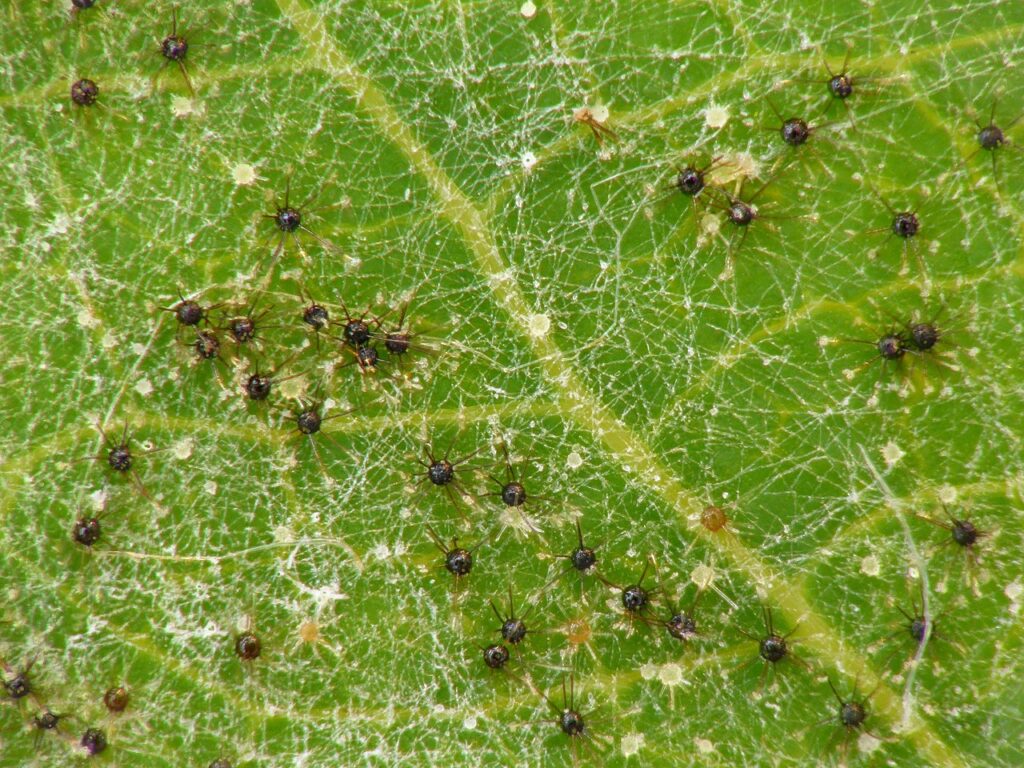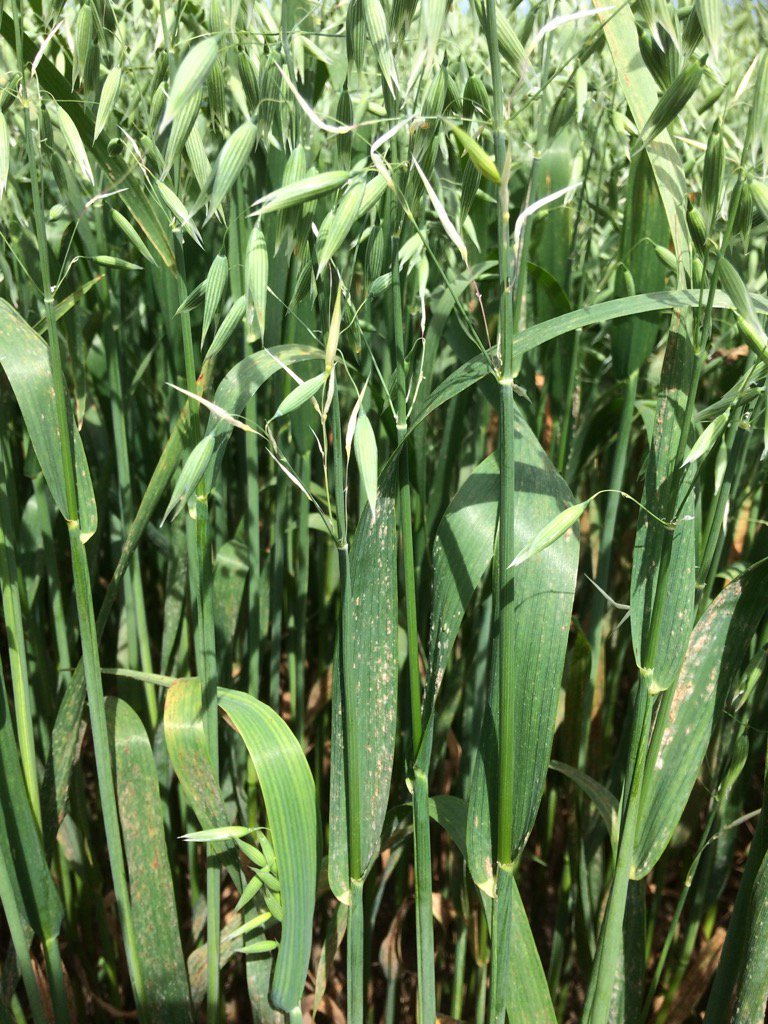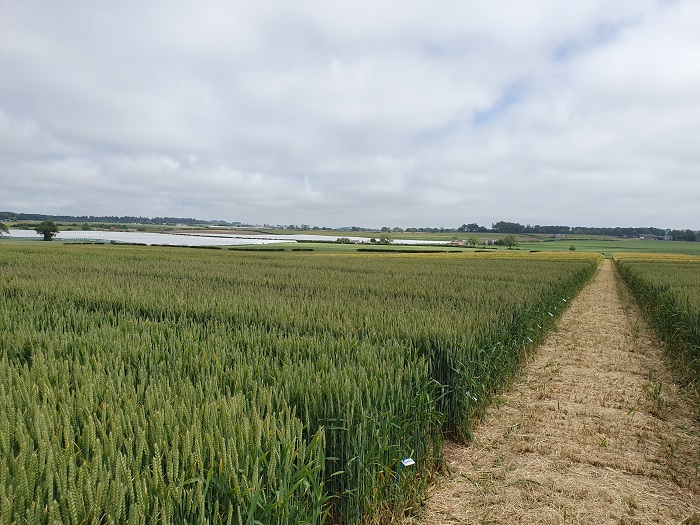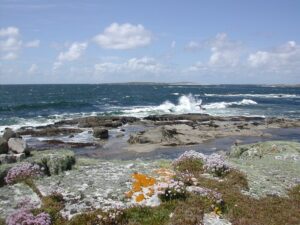Plant genetics, disease resistance in cereal crops and the pathogen responsible for the Irish potato famine with Dr Angela Feechan, School of Agriculture and Food Science.

Q: You work on plants and plant pathogens in particular. Tell us a little bit about how you became interested in this?
A: I lived next to a woodland park growing up, so I was always interested in plants! Originally, I went to do genetics at university and then realised that I could do both plants and genetics at the same time by doing plant science. As time went on, I became interested in disease resistance, because it is something that’s actually useful. So I started off in genetics and then moved into plant genetics and even then, more focussed on the genes that you could use for disease resistance. I ended up doing a PhD in disease resistance in plants, at Edinburgh university. As I did my undergrad and my PhD there I was keen to move so, went to Copenhagen for a couple of years for my postdoctoral research. There I worked on powdery mildew. Each powdery mildew species is specific for that plant so barley mildew will infect barley, wheat mildew infects wheat and so on. After that, I moved to Australia to work on mildew again, but on grapevine. Australia has a huge wine industry, and one of the main issues is that they have mildew on the grapes. I spent six years there working on resistance genes to grape mildew.
Q: Did you get to sample lots of wine?
Yes! The whole campus that we worked on was basically working on grapevine. The building that I worked in, everybody worked on grapes. We worked on diseases, one of the groups worked on flavour, another on flowering, another on ripening. The viticulture students would make wine every year, and they’d sell off the wine.
Q: In terms of genetics and crop science, how has knowledge and science developed in recent years?
A: People have been looking for and identifying disease resistance genes for a long time. But little was known about crop pathogen genomes. Due to high-throughput sequencing, over the last ten years or so we were able to know about more about the genetics of the plant pathogens. At the end of my time in Australia, we had started to think more about the fungal pathogen genome, to complement the resistance gene work. Then when I moved to UCD, Fiona Doohan’s group were doing important work on cereal resistance genes. I started to focus more on what are the genes in the fungus, in the pathogen itself, needed to cause crop disease, and then the interactions between the crop and the pathogen. This means we work closely and complement work in Fiona’s lab. You can’t really understand disease without both sides, it’s a two-way interaction between the pathogen that’s trying to attack and the organism that’s trying to protect itself. You need to understand both sides.

“You can’t really understand disease without both sides, it’s a two-way interaction between the pathogen that’s trying to attack and the organism that’s trying to protect itself.”
– Dr Angela Feechan
Image: magnified powdery mildew.
Q: Do you look at lots of different pathogens?
A: We tend to focus on fungal pathogens of cereals, although we do have a project on cherry laurel. We work on Septoria tritici blotch in wheat which is our main focus where we look at pathogen genes and proteins needed to cause disease. Basically, the fungus secretes proteins to try and switch off the plant’s immune system, to try and get to wheat host to do what it wants. We try to work out what are those secreted proteins because there are hundreds of them, and no one really knows what they do. We also work on powdery mildew in oats, on that project, Aisling was trying to find the resistance genes on the plant side.
Q: What kinds of pathogen outbreaks have there been recently in crops?
A: Septoria would be the biggest problem in wheat. There are outbreaks every year but they are controlled with fungicide. You could have a 50% yield loss because of Septoria, but because we spray, that’s controlled. It isn’t really sustainable, the EU is trying to phase out the fungicides that we’re using. For instance chlorothalonil is a multi-site fungicide which was used predominantly to control septoria in wheat and also things, like Ramularia in barley, which is a related fungus. But as of May 2020, the EU have said you can’t use that anymore. Then you are looking at using a different multi-site fungicide.
Q: Can you explain what a multi-site fungicide does?
A: Multi-site fungicides have more than one target. The single sites are really specifically, they target one enzyme or one particular process in the fungus. A multi-site might damage the membrane of the fungus. The fungus can’t really evolve to overcome that. Whereas if you have a fungicide that only targets one enzyme, then the fungus can just evolve to change that enzyme. More and more, multi-sites are being removed by the EU.
Q: Did the EU’s removal of the multisite have a big effect on crops?
I guess we’ll find out more this year, but growers this year will likely use a different multi-site called folpet. There was a lot of concern over the ban and grower groups were trying hard to lobby the EU not to ban it, but they did.
Q: What kinds of disciplines and approaches come into the study of plants and plant pathogens?
A: We would use microbiology, molecular biology, genetics and bioinformatics. Agronomy is also important.
“We can grow wheat in controlled GM chambers and then infect that wheat with the normal wild type septoria fungus and then compare that to the mutant septoria and see what the difference is. One of the things we found is just by removing one gene that septoria becomes really slow, there’s less disease symptoms, it can’t make as many spores. What we’ve done is work out that there’s a gene that the fungus needs to cause disease”
– Dr Angela Feechan

Q: Do you grow your own plants?
A: We have field trials as part of part of projects like BioCROP at UCD Lyons Farm and we are also part of CONSUS, there’s field trials as part of CONSUS in the UK where we go and take samples in the field, or use a spore trap which traps fungal spores in the fields. We grow plants in the glasshouse, or in the in the growth chambers at UCD Rosemount Environmental Station. For example, if we think there’s a gene that includes one of these secreted proteins and we think that this is really important for how virulent or aggressive the fungus is, we can use a GM technique to knock that gene out in the fungus.
We can grow wheat in controlled GM chambers and then infect that wheat with the normal wild type septoria fungus and then compare that to the mutant septoria and see what the difference is. One of the things we found is just by removing one gene that septoria becomes really slow, there’s less disease symptoms, it can’t make as many spores. What we’ve done is work out that there’s a gene that the fungus needs to cause disease. Technically there are ways that you can genetically modify the plant to silence things in the fungus. But they’re unlikely to be used in the EU. You know we think there’s 200 of these genes that are needed for aggressiveness or virulence. With septoria for instance, we only know what around five of them do. If we don’t understand what the fungus is doing, it’s difficult to try and stop it causing disease.
Some of these secreted proteins are directly interact with resistance genes in the plant. This is interesting because we didn’t actually set out to do this, Fiona’s group were working on resistance genes in this resistant wheat cultivar called Stigg. They found three resistance proteins that the plant needed to be resistant. My lab had been working on the secreted proteins from the fungus, and then Sujit and Binbin were talking to each other from the two labs, and wondering if they interact with each other. They checked this out and ended up discovering the resistance protein from the Stigg wheat variety is in fact binding to proteins from the Septoria fungus. We still don’t really know why. It shows you how it’s really lucky we share the lab and ideas.
Q: You work mainly on fungal pathogens – what about other types?
Most of the cereal pathogens are fungal. But there are bacterial pathogens as well, in my PhD I worked on bacteria. We also work on cherry laurel and bacterial pathogens that cause shot-hole disease an important plant for the cut foliage industry. We recently found a new bacterial pathogen of cherry laurel called Micrococcus aloeverae.

“Once you have a pathogen in a country, it’s quite difficult to get rid of it because they have evolved to spread. Single spores are spread by wind in the atmosphere. Once they get released, they can travel hundreds of kilometres in the upper atmosphere”.
– Dr Angela Feechan
Image: oats infected with plant pathogen.
Q: Does climate change have the potential to create new pathogens?
Yes. I think this has a real potential to impact the range of pathogen . For example, there’s a bacterial pathogen of potato called brown rot (alstonia solanacearum). It prefers higher temperatures. It’s a notifiable quarantine pathogen. And it just pops up in Ireland now and again. It popped up in 2007 and there was an outbreak. This just shows if you have warmer conditions, things that maybe weren’t a problem before can become a problem. Then look at something like the Micrococcus bacteria, we found in cherry laurel. We were actually looking for a pathogen called Pseudomonas syringae pv. syringae, which is the pathogen that is supposed to commonly cause short hole disease on cherry laurel.
When we took leaf samples we kept finding this round bacteria, rather than we were actually looking for a rod shaped one. First of all I just kept thinking oh, this is a mistake, but eventually we discovered it was this Micrococcus, aloeverae. We compared the temperature growth for both of them and the Pseudomonas bacteria which is the one, the typical shot-hole pathogen, it could grow even at four degrees, really slowly. It started to drop off in the 30s whereas the Micrococcus, the new one that we found, it was the opposite, it liked the warm temperatures. Then you say to yourself, where’s this Micrococcus come from and also, is it going to become a problem?
Q: Do you sometimes look at projected scenarios around climate and conditions for these pathogens?
We’ve never done a prediction in terms of climate, but we would check the temperature range of pathogens. We have the climate chambers down at Rosemount Environmental Station, they can do elevated CO2 as well as temperature. Fiona’s group did an experiment where they put a fungal pathogen of wheat that causes Fusarium head blight in elevated CO2, and they found that they got more disease in elevated carbon dioxide levels. It would be great to test this for other pathogens.
Q: Fungal pathogens were very famously involved in the Irish potato famine, is that correct?
It’s actually an oomycete! One of the things I drive my students bonkers with is ‘it’s not a fungus’. It’s like a fungus but it’s not. Have you ever heard of sudden oak death? It’s a pathogen that got introduced in the late 2000s and had a huge impact on forestry. The species that causes oak death is caused by Phytophthora ramorum. Phytophthora infestans is the pathogen that causes late blight on potato. So they are cousins. Oomycetes are more related to algae than they are to fungi. That’s why they love wet conditions.
Q: Once a new pathogen comes into an environment, how easy is it to spread? They are so tiny it’s hard to imagine how they travel so widely
A: Once you have a pathogen in a country, it’s quite difficult to get rid of it because they have evolved to spread. Single spores are spread by wind in the atmosphere. Once they get released, they can travel hundreds of kilometres in the upper atmosphere. I think Jon Yearsley had a project modelling spore release in this way. Bacteria can get onto insects or animals, they can get moved around, they can spread via rain splash. Rain splash is important for bacterial and also fungal pathogen spread. Rain can spread pathogens quite far, it hops thirty centimetres, thirty centimetres, thirty centimetres and so on.
“Rhododendron carries Phytophthora ramorum or sudden oak death. It’s a misleading name because it can infect different trees! It can spread into forests because of the Rhododendron, because the pathogen can infect rhododendron. Rhododendron is itself an invasive species and has become a source of the inoculum. In some areas, in the UK and Ireland they had to clear huge areas of forest because of this introduced pathogen.”
– Dr Angela Feechan

Q: Can you explain a little about this concept of biosecurity to someone who hasn’t heard it before, and why it’s so important?
Well, we don’t want any invasive species. It’s a problem especially if it’s a pathogen that’s introduced into either crops or even an ecosystem where it can cause damage to plant species. For example, Rhododendron carries Phytophthora ramorum or sudden oak death. It’s a misleading name because it can infect different trees! It can spread into forests because of the Rhododendron, because the pathogen can infect rhododendron. Rhododendron is itself an invasive species and has become a source of the inoculum. In some areas, in the UK and Ireland they had to clear huge areas of forest because of this introduced pathogen.
Q: What kind of measures are in place in terms of biosecurity?
There are international rules about the movement of plants. The EU has a set of rules, a set of quarantine pests and a pest risk assessment for every single pathogen. You would consider things like how it spreads, what temperature it grows at, how it might be introduced into countries, would it be introduced through trade or would it enter through plant material. They would decide how likely it is to become a problem and whether it should be put on a quarantine list. If certain countries don’t have a pathogen present they can apply for protected zone status. A lot of it does depend on inspecting imports or people following the rules. Recently the EU brought in the plant passport system which should help with traceability.
Q: In terms of tillage in Ireland, what kinds of things might we consider in terms of sustainability?
A: The EU wants a 50% reduction in pesticide use and a 20% reduction in fertiliser use through the Farm to Fork programme. There are concerns around pesticide residues and the high energy costs for making fertilisers, associated green house gas emissions and runoff into waterways. Most the cereal, in fact most of the crops in Ireland end up for animal feed. Even then most of the feed is imported into Ireland from South America.
Q: Tell me about your new BioCrop project funded by the Department of Agriculture, Food and the Marine
As mentioned before less and less pesticides are available and the EU wants a 50% reduction in pesticide use and 20% reduction in fertilisers through the Farm to Fork programme. The BioCrop project was put together before Farm to Fork strategy was announced, but it lined up very well. We had been working on biostimulants before on a project with we did for Tony’s PhD with Alltech. We had also started looking at biopesticides, because we think some of these fungal secreted proteins may be anti-microbial. NUIG had been working with seaweed and anti-microbials from seaweed. Then
Fiona’s lab was working on endophytes, which are bacteria or fungi that live inside the plant, she has a spin out company with Trinity called eSEED. Teagasc are looking at controlling different diseases in the field, Barley Yellow Dwarf Virus and Ramularia. So BioCrop will look at endophytes coated on seed and test if they work and if they would promote crop health and maybe control disease. We can also test the antimicrobials we identify.
We had spoken to different companies including Brandon Bioscience, a biostimulant company that makes biostimulants from seaweed. Saoirse and Rainer will test these and other products as alternatives to conventional fertiliser use. Then to complete the story Fionnuala will look at the life cycle assessment of these biostimulants and biopesticides to assess their environmental impact. Fiona at Teagasc and Micheal here at UCD will assess the economics of these products for growers. The project has the biostimulants, the biopesticides, economics, the life cycle assessment, and because there had been a lot of work in these areas at the different partners already, then it all just came together.



